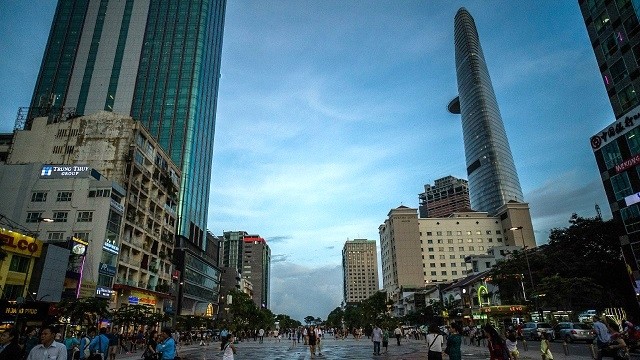Donald Lambert, a specialist in charge of the private sector development under the ADB’s Southeast Asia Department, has said that with its new socio-economic development plan that will cover 2021 through 2025 and another new socio-economic development strategy covering 2021 through 2030, Vietnam is expected to establish ambitious development targets which are appropriate for a country that has achieved much over recent years. However, Vietnam will need to adopt new approaches to fund its development amidst many changes since its last five-year socio-economic development plan.
Vietnam’s per capita income has been increasing at a compound annual growth rate of over 6%, making it among the fastest growing economies in the world. It is now firmly established as a middle-income country and is one of the most attractive destinations for foreign direct investment.
This success means, however, that donors will begin to allocate grants and other forms of deeply concessional assistance to countries with more pressing needs, according to Lambert. In 2015, Vietnam was the 5th largest recipient of net official development assistance and qualified for some of the most concessional assistance from ADB and other donors. In 2017, it “graduated” from the World Bank’s concessional country classification and 18 months later from ADB’s equivalent grouping.
Lambert said that ADB and others have been trying to cushion this transition by blending grants with its lending to Vietnam to reduce net borrowing costs. Additionally, ADB in 2019 approved a new pricing policy that provides a temporary benefit to countries, like Vietnam, that are recent graduates from the most concessional assistance. Although helpful, these measures are temporary and inherently limited and will not provide the funding paradigm for Vietnam’s next socio-economic development plan.
These funding needs, moreover, are considerable. ADB has estimated that Southeast Asia will need to invest on average US$210 billion in infrastructure per year through 2030. Vietnam will require a large portion of this with the Global Infrastructure Hub estimating that Vietnam needs to invest US$110 billion between 2021 and 2025 for infrastructure and to meet the Sustainable Development Goals. Based on historical trends, this leaves a projected US$22 billion funding shortfall.
US$22 billion over five years is a big number, Lambert said, adding that it’s not insurmountable. In fact, Vietnam is in a better position than many. Whereas the Philippines, India, and other Asian countries have privately funded a large portion of their infrastructure, the private sector has historically only funded 10% of Vietnam’s. That means there is a lot of scope for Vietnam – particularly given its compelling growth story – to attract more infrastructure investment.
To make this happen, Lambert offered three key strategies that Vietnam can pursue. The first is more catalytic use of development assistance. This requires a different mindset, according to the ADB expert. Vietnam is no longer a low-income country, but it is also not ready to fund itself exclusively through private investment and domestic capital markets. A transition period is needed where Vietnam uses donors’ assistance to catalyse private investment that would not come otherwise, he suggested.
This transition period will, however, require new tools. This includes issuing counter-guarantees to ADB and other development partners so they can use their strong international credit ratings to de-risk projects. Vietnam should also prioritise development assistance to strengthen the financial sector, providing stand-by facilities or other enhancements to make it easier for state-owned enterprises tasked with key projects to access affordable financing, while allowing development partners to issue dong-linked bonds to lower the cost of capital for Vietnamese borrowers.
Using development assistance catalytically to attract private investment closely ties to the second priority: passing a strong law on public-private partnerships (PPP). The National Assembly has already considered a first draft of the bill and hopes to pass a second version in May. Consultations should focus on the key missing ingredients needed to attract international investment. For example, the law needs to better mitigate the risk that the demand for an infrastructure project falls short of projections. Vietnam already does this with feed-in-tariffs for power generation projects. The PPP law should afford similar protection to other sectors, particularly transport. This can be achieved through minimum revenue guarantees or ensuring that availability payments extend automatically beyond the current ceiling of five years.
The final strategic priority is better mobilisation of domestic capital markets, Lambert suggested. The passage of the new Securities Law in November 2019 was a good step as are recent regulatory changes that encourage companies to turn to the bond market instead of banks to fund long-term obligations. However, more is needed. According to the ADB official, private pension funds, investment funds, and insurance companies all need to mature so there’s a strong base of demand for corporate bonds.
Meanwhile, the main public pension, the Social Insurance Agency, must firstly be able to prudently manage and secondly start to invest in corporate debt. Vietnam needs to establish a domestic credit rating agency, and the government should actively market this investment opportunity to leading international rating agencies. These steps will help the corporate bond market to evolve, eventually creating opportunities for project bonds, particularly if credit enhancement mechanisms are available for these instruments.
Lambert said Vietnam’s graduation from concessional funding sources is unequivocally positive. It is a direct result of the dynamism and potential of this thriving economy. The trick now is to manage that success by evolving its strategy to fund the next five-year plan.
On the other hand, Vietnam cannot increase the share of private investment in infrastructure instantaneously, he suggested. A measured strategy that deploys development assistance catalytically, strengthens PPPs, and makes better use of domestic capital would establish the resource base for Vietnam’s next socio-economic development plan and beyond, Lambert concluded.
















